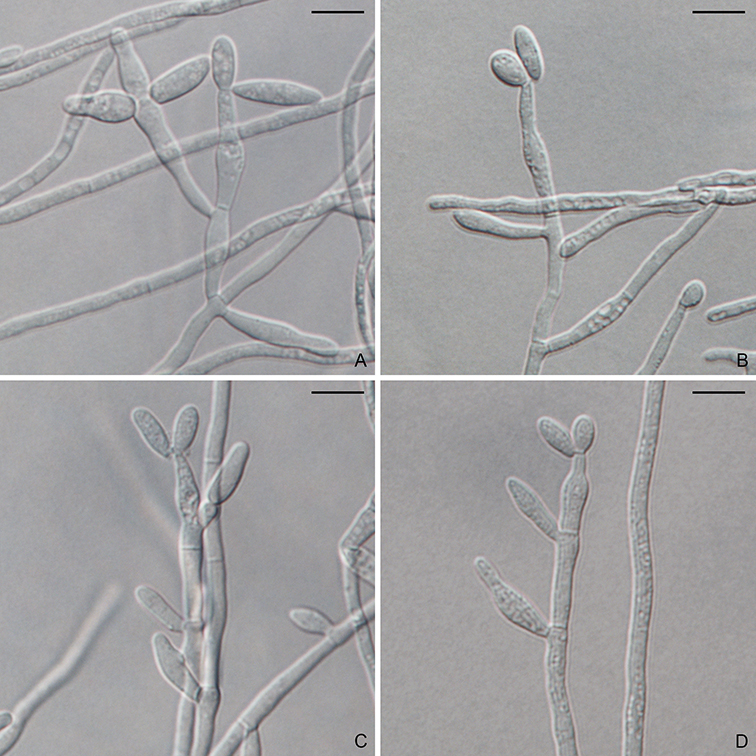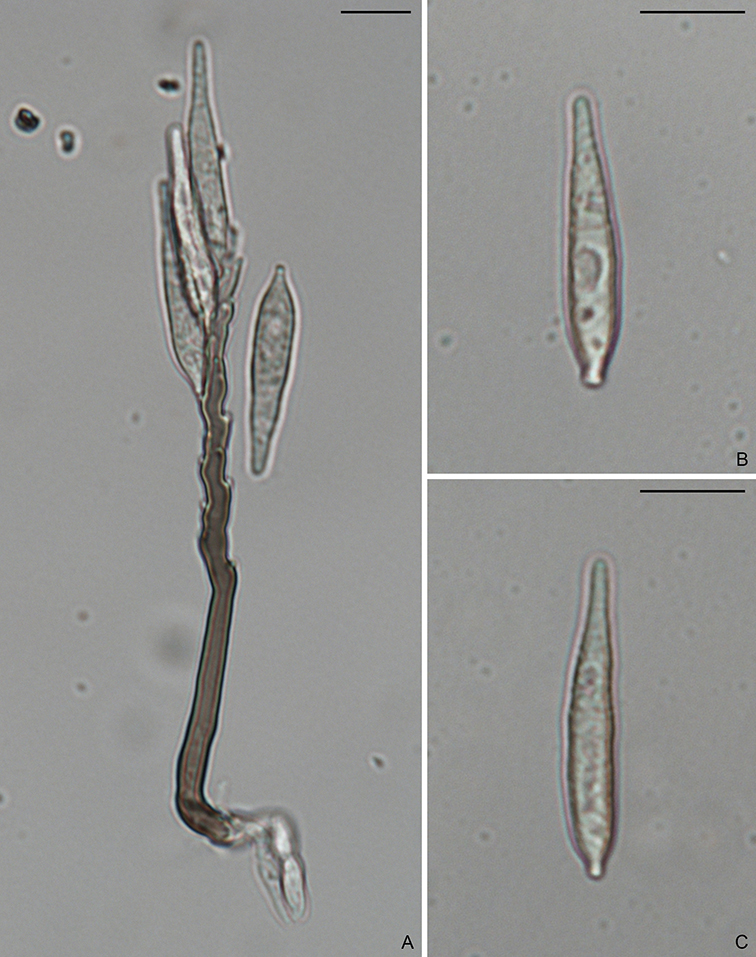
Figure. Magnaporthiopsis cynodontis (RS7-2). A–D. Conidiophores and conidia. Scale bars: A–D = 10µm.
Magnaporthiopsis cynodontis P.L. Vines & M. Tomaso-Peterson, Mycologia 112: 60 (2020).
MycoBank: MB812294.
Asexual state phialophora-like. On CMA, hyphae branched, septate, hyaline, smooth, 1.5–5 µm diam. Conidiophores micronematous, simple, unbranched or sparsely branched, hyaline. Conidiogenous cells phialidic, terminal or intercalary, erect, hyaline, 7–28 × 2.5–6 µm. Conidia aggregated in slimy heads, ovoid to ellipsoidal, straight or slightly curved, aseptate, hyaline, smooth, 6–13.5 × 2–7.5 µm. Sexual state unknown.
Colonies on PDA reaching 6.5 cm diam after 7 days at 25 °C in dark; surface floccose, parrot green; aerial mycelium yellowish; reverse cedar green. Colonies on CMA reaching 6.5 cm after 7 days in dark at 25 °C; surface sulphur yellow; aerial mycelium sparse; reverse light greenish-yellow.
Typification: Holotype BPI893103. Isotype RUTPPRS7-2. Ex-holotype culture CBS141700.
Gene sequences: KP129327 (18S), KJ855508 (ITS), KM401648 (28S), KP007351 (MCM7), KP268930 (RPB1), KP282714 (TEF1).
Specimens examined: USA, Alabama, Birmingham, from roots of Cynodon dactylon × C. transvaalensis, Jul. 2012, P.L. Vines & M. Tomaso-Peterson, GSGC10-2; Hawaii, Maui, from roots of Cynodon dactylon × C. transvaalensis, Jul. 2012, P.L. Vines & M. Tomaso-Peterson, KR10-6; Minnesota, Saint Paul, from roots of Festuca brevipila, Oct. 2017, D. Petrella & E. Watkins, 171013HF1-1, 171013HF2-3, 171013HF4-8; Mississippi, Starkville, from roots of Cynodon dactylon × C. transvaalensis, Jul. 2012, P.L. Vines & M. Tomaso-Peterson, RRFCHMP1-3, RRFMV10-2; New York, from roots of Agrostis palustris/Poa annua mix, Jul. 2018, S. Tirpak & R. Buckley, D29387-3, D29485-1; Oregon, Canby, from roots of Festuca, Sep. 2017, K. Scott, 17918FB4-11; Pennsylvania, Presto, from roots of Poa annua, Aug. 2018, S. Tirpak & R. Buckley, D29740-1,D29740-2, D29740-4; Tennessee, Memphis, from roots of Cynodon dactylon × C. transvaalensis, Jun. 2012, P.L. Vines & M. Tomaso-Peterson, TPC4-5, TPC5-3; Texas, Houston, from roots of Cynodon dactylon × C. transvaalensis, Jul. 2012, P.L. Vines & M. Tomaso-Peterson, HCC3-4; ibid. Humble, from roots of Cynodon dactylon × C. transvaalensis, Jun. 2012, P.L. Vines & M. Tomaso-Peterson, RS3-1, RS5-5, RS7-2 (BPI893103, RUTPPRS7-2).
Hosts/substrates: From roots of Agrostis, Cynodon, Festuca and Poa (Poaceae).
Distribution: USA (Alabama, Hawaii, Minnesota, Mississippi, New York, Oregon, Pennsylvania, Tennessee, Texas).
Notes: This species has been isolated from roots of Agrostis, Cynodon, Festuca and Poa with summer patch-like symptoms (Vines et al., 2019).
Copyright 2022 by The American Phytopathological Society. Reproduced, by permission, from Luo, J., and Zhang, N. 2022. The Rice Blast Fungus and Allied Species: A Monograph of the Fungal Order Magnaporthales (https://my.apsnet.org/APSStore/Product-Detail.aspx?WebsiteKey=2661527A-8D44-496C-A730-8CFEB6239BE7&iProductCode=46826). American Phytopathological Society, St. Paul, MN.


